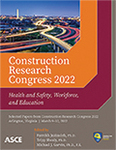Effect of Time Pressure and Cognitive Demand on Line Workers’ Risk-Taking Behaviors: Assessment of Neuro-Psychophysiological Responses in a Mixed-Reality Environment
Publication: Construction Research Congress 2022
ABSTRACT
Recent research suggests construction workers fall prey to the cognitive biases of risk compensation, wherein workers offset safety improvements by taking more risks. Parallel previous literature indicates that time pressure and mental load may increase workers’ arousal and stress. However, it is unclear whether time, productivity, and/or cognitive demands can worsen risk compensation behaviors by stimulating workers to make riskier decisions to complete tasks faster. Combining a multi-modal mixed-reality environment with wearable neuro-psychophysiological sensors, this study examines changes in safety and task performance for high-risk electrical-line tasks simulated under time/performance pressure and cognitive demand. The results show risk-compensation is in play as subjects over-rely on safety technologies and maintain their risk perception even while undertaking more risks to adapt to increased time pressure and/or cognitive demand. This paper contributes to body of knowledge by affecting safety-training approaches and the controls needed when providing workers with safety protection and new technological advances.
Get full access to this article
View all available purchase options and get full access to this chapter.
REFERENCES
Cœugnet, S., Naveteur, J., Antoine, P., and Anceaux, F. (2013). “Time pressure and driving: Work, emotions and risks.” Transportation Research Part F: Traffic Psychology and Behaviour, Elsevier Ltd, 20, 39–51.
ESFI. (2019). ” Workplace Safety Workplace Injury & Fatality Statistics 2003-2019” https://www.esfi.org/workplace-injury-and-fatality-statistics (Accessed June 8, 2020).
Fairclough, S. H., Burns, C., and Kreplin, U. (2018). “FNIRS activity in the prefrontal cortex and motivational intensity: impact of working memory load, financial reward, and correlation-based signal improvement.” Neurophotonics, SPIE-Intl Soc Optical Eng, 5(03), 1.
Gholizadeh, P., and Esmaeili, B. (2020). Cost of Occupational Incidents for Electrical Contractors: Comparison Using Robust-Factorial Analysis of Variance. Journal of Construction Engineering and Management, 146(7), 04020073.
Hasanzadeh, S., Dao, B., Esmaeili, B., and Dodd, M. D. (2017). “Measuring the Impact of Working Memory Load on the Safety Performance of Construction Workers.” American Society of Civil Engineers (ASCE), 158–166.
Hasanzadeh, S., and de la Garza, J. M. (2020). “Productivity-Safety Model: Debunking the Myth of the Productivity-Safety Divide through a Mixed-Reality Residential Roofing Task.” Journal of Construction Engineering and Management, American Society of Civil Engineers (ASCE), 146(11), 04020124.
Hasanzadeh, S., de la Garza, J. M., and Geller, E. S. (2020). “Latent Effect of Safety Interventions.” Journal of Construction Engineering and Management, American Society of Civil Engineers (ASCE), 146(5), 04020033.
Liko, G., Esmaeili, B., Hasanzadeh, S., Dodd, M. D., and Brock, R. (2020). “Working-memory load as a factor determining the safety performance of construction workers.” Construction Research Congress 2020, American Society of Civil Engineers (ASCE), 499–508.
Mitropoulos, P., Abdelhamid, T. S., and Howell, G. A. (2005). “Systems Model of Construction Accident Causation.” Journal of Construction Engineering and Management, American Society of Civil Engineers (ASCE), 131(7), 816–825.
Nahrgang, J. D., Morgeson, F. P., and Hofmann, D. A. (2011). “Safety at Work: A Meta-Analytic Investigation of the Link Between Job Demands, Job Resources, Burnout, Engagement, and Safety Outcomes.” Journal of Applied Psychology, J Appl Psychol, 96(1), 71–94.
Nepal, M. P., Park, M., and Son, B. (2006). “Effects of Schedule Pressure on Construction Performance.” Journal of Construction Engineering and Management, American Society of Civil Engineers (ASCE), 132(2), 182–188.
Park, H.-S., Thomas, S. R., and Tucker, R. L. (2005). “Benchmarking of Construction Productivity.” Journal of Construction Engineering and Management, American Society of Civil Engineers (ASCE), 131(7), 772–778.
Pleskac, T. J. (2008). “Decision Making and Learning While Taking Sequential Risks.” Journal of Experimental Psychology: Learning Memory and Cognition, 34(1), 167–185.
Rao, H., Korczykowski, M., Pluta, J., Hoang, A., and Detre, J. A. (2008). “Neural correlates of voluntary and involuntary risk taking in the human brain: An fMRI Study of the Balloon Analog Risk Task (BART).” NeuroImage, Neuroimage, 42(2), 902–910.
Santamaría-Bonfil, G., Ibáñez, M. B., Pérez-Ramírez, M., Arroyo-Figueroa, G., and Martínez-Álvarez, F. (2020). “Learning analytics for student modeling in virtual reality training systems: Lineworkers case.” Computers and Education, Elsevier Ltd, 151.
Strangman, G., Franceschini, M. A., and Boas, D. A. (2003). “Factors affecting the accuracy of near-infrared spectroscopy concentration calculations for focal changes in oxygenation parameters.” NeuroImage, Academic Press Inc., 18(4), 865–879.
Ulrich-Lai, Y. M., and Herman, J. P. (2009). “Neural regulation of endocrine and autonomic stress responses.” Nature Reviews Neuroscience, Nat Rev Neurosci.
Unni, A., Ihme, K., Surm, H., Weber, L., Ludtke, A., Nicklas, D., Jipp, M., and Rieger, J. W. (2016). “Brain activity measured with fNIRS for the prediction of cognitive workload.” 6th IEEE Conference on Cognitive Infocommunications, 349–354.
Wilde, G. J. S. (1982). “The Theory of Risk Homeostasis: Implications for Safety and Health.” Risk Analysis, John Wiley & Sons, Ltd, 2(4), 209–225.
Zhou, X., Hu, Y., Liao, P. C., and Zhang, D. (2021). “Hazard differentiation embedded in the brain: A near-infrared spectroscopy-based study.” Automation in Construction, 122, 103473.
Information & Authors
Information
Published In
History
Published online: Mar 7, 2022
Authors
Metrics & Citations
Metrics
Citations
Download citation
If you have the appropriate software installed, you can download article citation data to the citation manager of your choice. Simply select your manager software from the list below and click Download.
